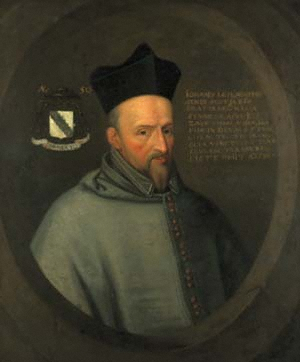John Lesley facts for kids
Quick facts for kids John Lesley |
|
|---|---|
| Bishop of Ross | |
 |
|
| Church | Roman Catholic Church |
| See | Diocese of Ross |
| In Office | 1567–1592 |
| Predecessor | Henry Sinclair |
| Successor | David Lindsay |
| Orders | |
| Consecration | 1567 |
| Personal details | |
| Born | 29 September 1527 Kingussie |
| Died | 31 May 1596 (aged 68) Guirtenburg (Belgium) |
| Previous post | Archdeacon of Moray (1565–7); Commendator of Lindores (1566–8) |
| Alma mater | University of Aberdeen |
John Lesley (born September 29, 1527 – died May 31, 1596) was an important Scottish Roman Catholic bishop and a historian. He lived during a time of big changes in Scotland, especially with the Scottish Reformation, which was a shift from Catholicism to Protestantism. John Lesley was a strong supporter of Mary, Queen of Scots.
Early Life and Education
John Lesley was born in Kingussie, Scotland. He went to the University of Aberdeen and earned a master's degree. He also studied in France, at universities in Poitiers, Toulouse, and Paris. In 1553, he became a doctor of laws in Paris.
In 1558, he became a priest. He was appointed a canon in the cathedral church of Aberdeen. A canon is a type of priest who works closely with a bishop.
Supporting Mary, Queen of Scots
When the Scottish Reformation began, John Lesley became a leading voice for the Catholic Church. He debated with famous Protestant leaders like John Knox in 1561.
Later that year, he was one of the people sent to bring Mary, Queen of Scots, back to Scotland to rule. He returned with her and became one of her trusted advisors. He was made a privy councillor, which meant he advised the Queen on important matters. He also became a professor of canon law (church law) at King's College, Aberdeen.
In 1565, he became the Bishop of Ross. This was a very important position in the church. He also helped to update Scotland's laws. He was involved in printing a collection of laws called the Black Acts in 1566.
Life in Exile
John Lesley was a very loyal friend to Queen Mary. After she lost power and was held captive in England, he continued to work for her freedom. He tried to get help from other European leaders.
He was also involved in a plan for Queen Mary to marry Thomas, Duke of Norfolk. This plan was discovered and led to the Duke's execution. Because of his actions, John Lesley was arrested and put in the Tower of London.
While in prison, he started writing his famous History of Scotland. He wrote part of it in Scots (an old Scottish language) and gave it to Queen Mary to read while she was imprisoned. He also wrote a book called Piae Consolationes to comfort her.
In 1573, he was released from prison but was not allowed to stay in England. He traveled around Europe, trying to find support for Queen Mary. He met with Rudolf II, Holy Roman Emperor, in 1578.
He later moved to France and became a church leader in Rouen. However, he faced more trouble when he was imprisoned again and had to pay a lot of money to be set free. He was imprisoned again in 1590.
In 1593, he became the bishop of Coutances in Normandy. He eventually retired to a monastery near Brussels, where he died in 1596.
His Writings
John Lesley is best known for his historical writings. His main work is:
- De origine, moribus, ac rebus gestis Scotiae libri decem (On the Origin, Customs, and Deeds of the Scots, Ten Books). This is a history of Scotland written in Latin. It covers Scottish history from ancient times up to 1571.
- The first part of his history used information from earlier writers like Hector Boece.
- The later parts of his history are very important because they give a Catholic view of events. This helps historians understand the period better, especially when compared to histories written by Protestants like John Knox.
- A translation of his Latin history into Scots was made in 1596 by James Dalrymple.
He also wrote other works, including:
- A Defence of the Honor of Marie, Queene of Scotland (1569). This book defended Queen Mary's right to the throne.
- Piae afflicts animi consoleiones, ad Mariam Scot. Reg. (1574). This book offered comfort to Queen Mary during her difficult time.

